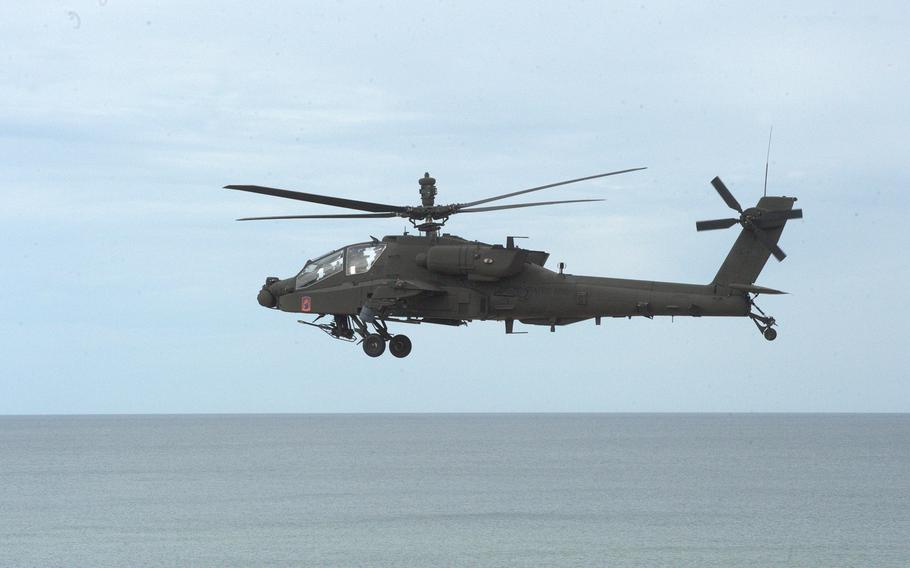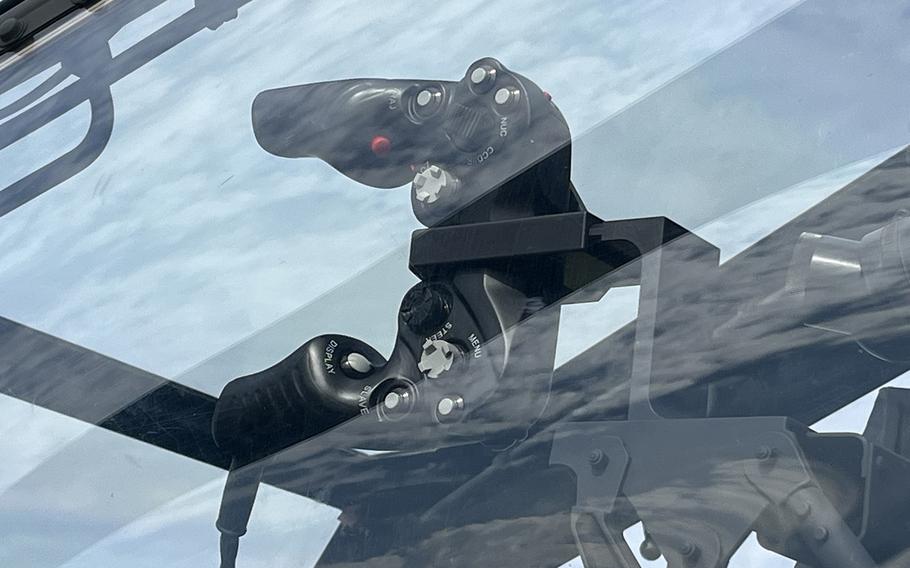
An Army AH-64E Apache helicopter from the 12th Combat Aviation Brigade returns to base Aug. 27, 2025, in Ustka, Poland, after the first European firing of a Spike Non-Line of Sight missile. (Matthew M. Burke/Stars and Stripes)
USTKA, Poland — With the Baltic Sea as their backdrop, American and Polish troops fired a new long-range missile from Apache helicopters in a first-of-its-kind European demonstration aimed squarely at deterring Russia.
Soldiers from U.S. Army Garrison Ansbach’s 12th Combat Aviation Brigade on Wednesday launched two Spike Non-Line of Sight missiles from AH-64E Apache helicopters at the Polish Air Force Training Center in Ustka.
The Israeli-made missiles traveled 16 miles out to sea to destroy a pair of floating targets in pinpoint strikes that were broadcast for brass from both nations.
Apache pilots can fire the weapon without seeing their target — even from behind mountains — and without exposing themselves to the enemy, said Chief Warrant Officer 5 Michael Weisskopf, the brigade standardization officer.
Produced by the Haifa-based Rafael Advanced Defense Systems, the Spike missile can destroy armor, air defense artillery, naval flotillas and even troop formations up to 30 miles away, or about four times the distance of the current Hellfire missile, said Weisskopf, who is also an Apache pilot.
The demonstration in Ustka came as Russia gears up for its major Zapad military exercise with Belarus.
“This shows the Russians, ‘Hey, we watch what you’re doing, and we’re here to deter any future aggression,’” V Corps commander Lt. Gen. Charles Costanza said prior to the exercise.
The missile launches were part of the third Polish Apache Initiative, a series of semiannual summits and exercises where U.S. Army aviators share their knowledge of tactics and maintenance, as well as train with Polish air force members.
Col. Krzysztof Kwiatkowski, chief of combat aviation for the helicopter branch of the Polish military, called the event very important for the development of the Polish air force. He credited V Corps with helping the Poles build a “new strength.”
Last year Poland purchased 96 Apaches, which will begin arriving in 2028. Warsaw has also been procuring upgrades to its existing tanks, jets and artillery systems. It is unclear if or when the Polish air force will obtain its own Spike NLOS missiles.
The missiles can lock on before or after being fired and can be guided into a target using a camera, screen and what looks like an Xbox gaming controller.
Guests at Wednesday’s launches watched on a giant screen for several minutes as the munition traveled to the targets, which were white boxes marked with X’s.
The pilots simulated their GPS systems being jammed by an adversary, which forced them to rely on the missile’s internal navigation and then manual control.
Applause erupted as the feeds showed the missiles heading for the center of the X’s, followed by static. Weisskopf called the missile a “game-changer.”
“It gives U.S. Army aviation and Apaches the capability to defeat and have overmatch on (air defense artillery) systems that we did not previously have that overmatch on with,” he said.

The Spike Non-Line of Sight missile can be guided to its target from afar using a controller, seen here following a live-fire demonstration on Aug. 27, 2025, in Ustka, Poland. (Matthew M. Burke/Stars and Stripes)